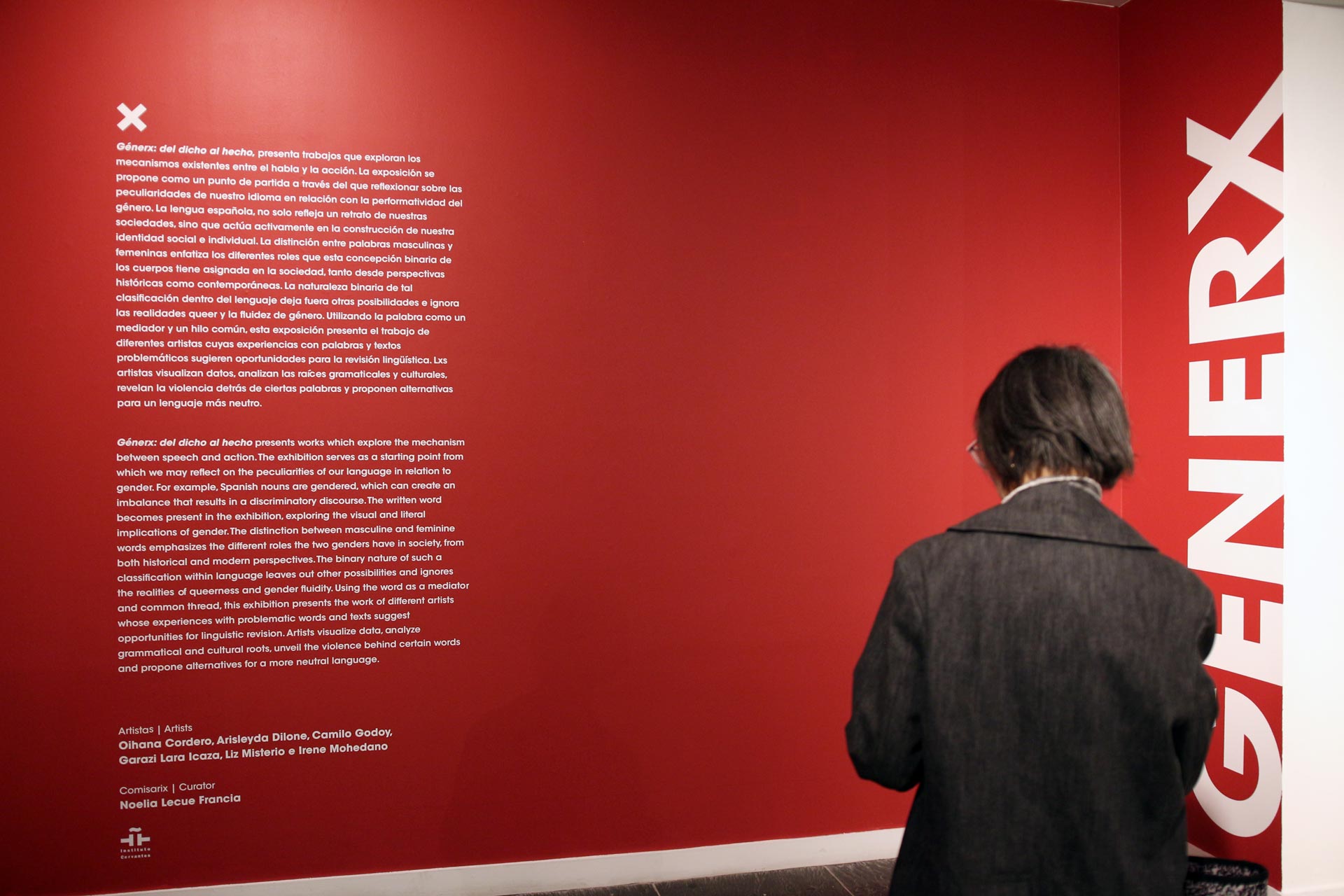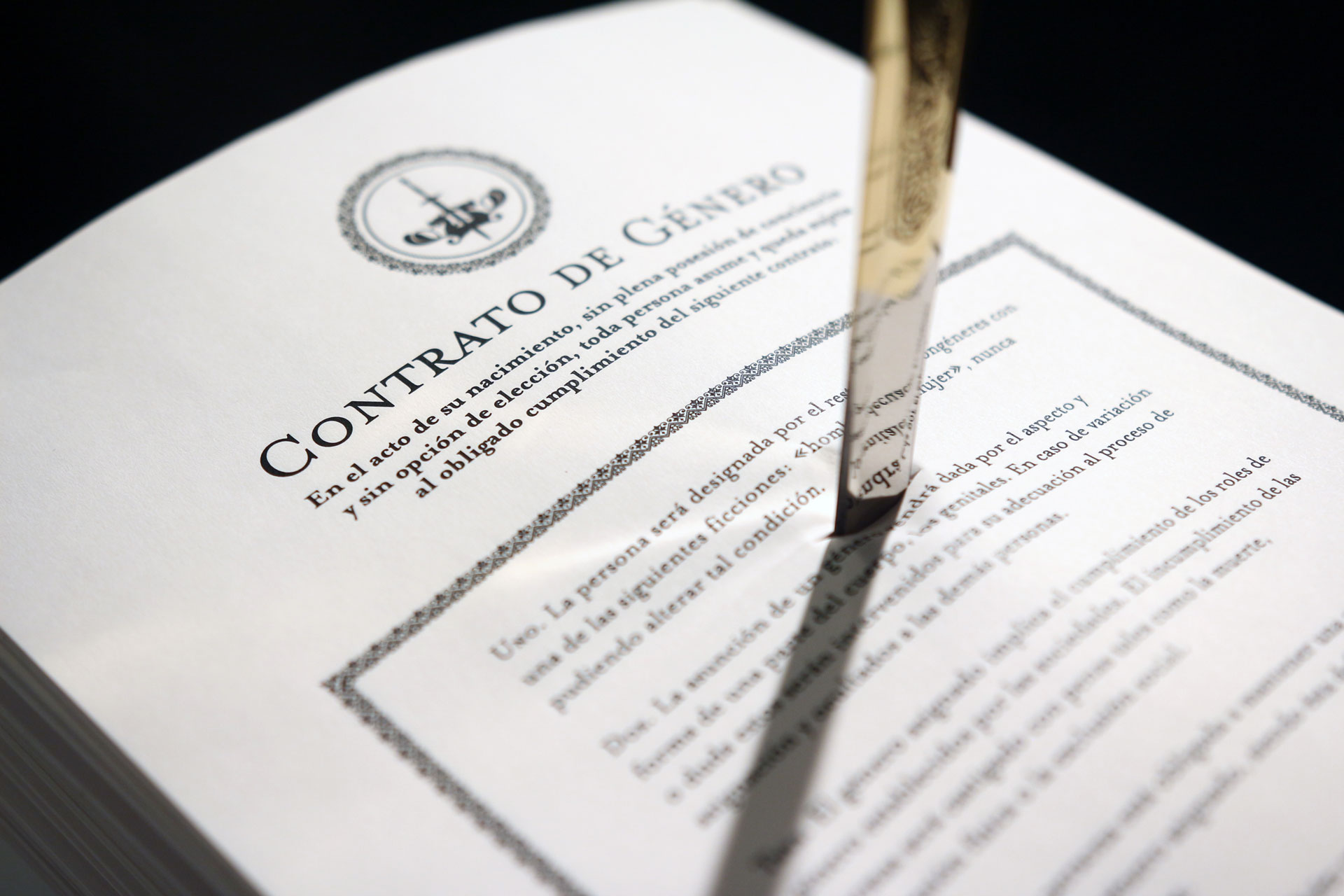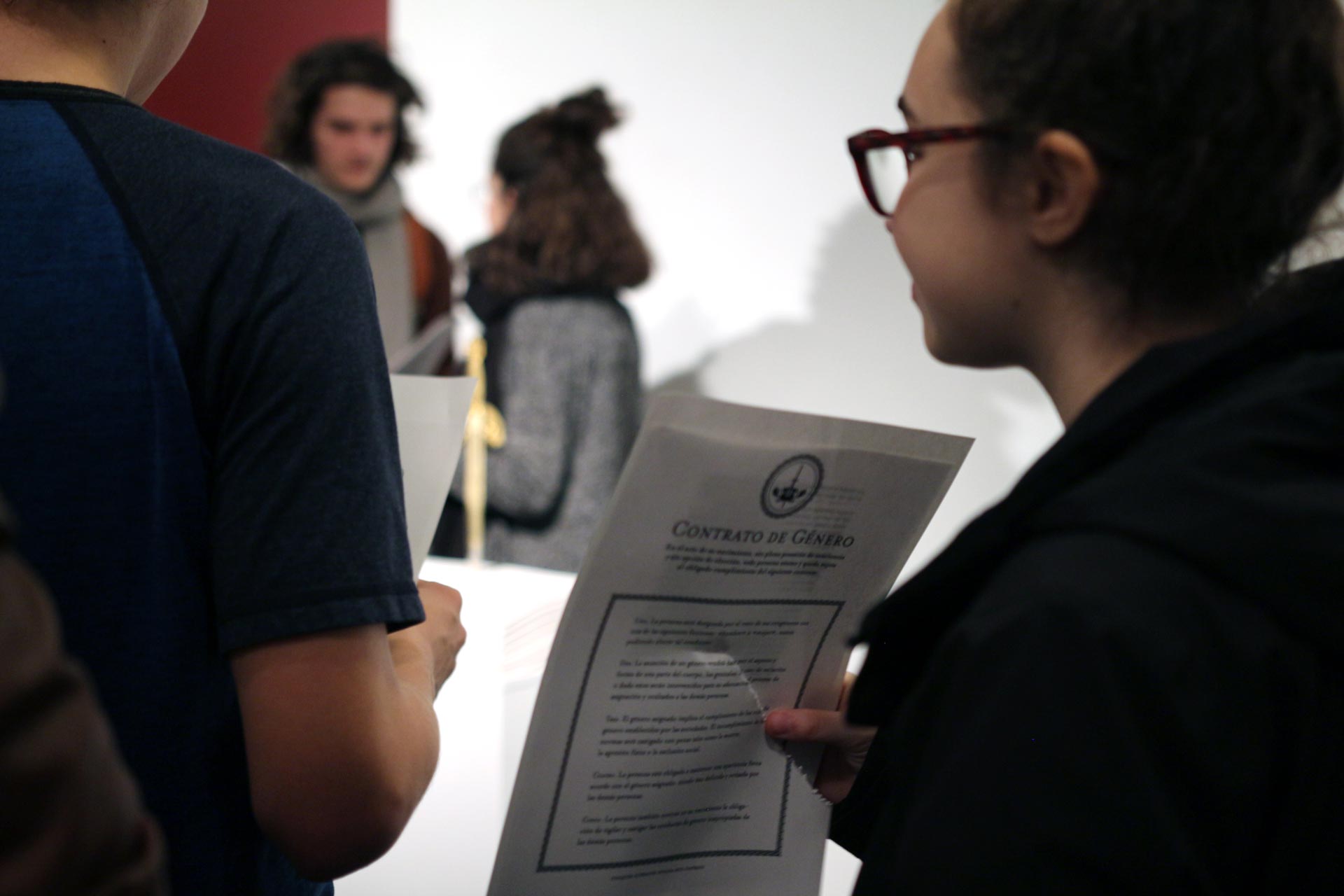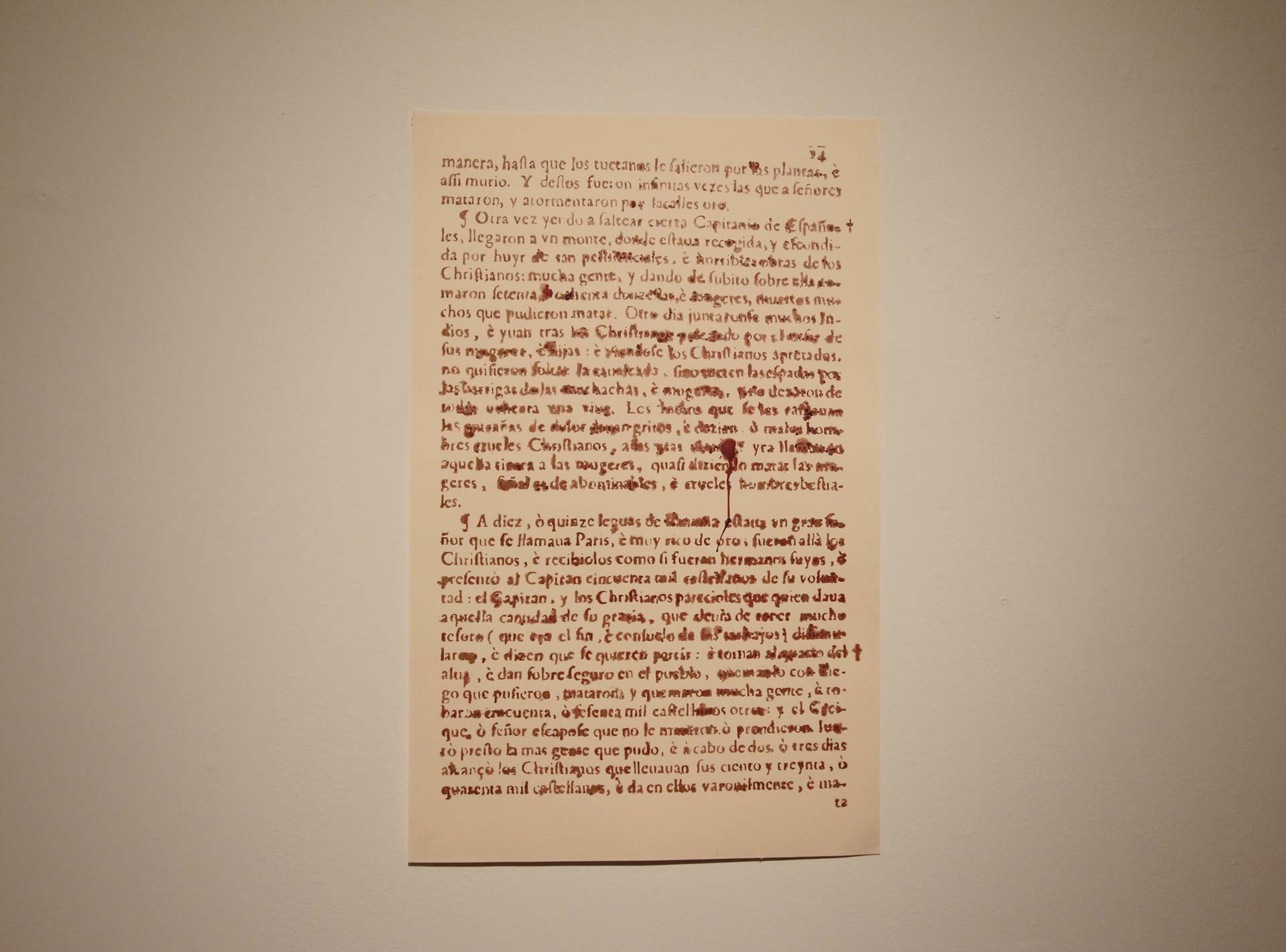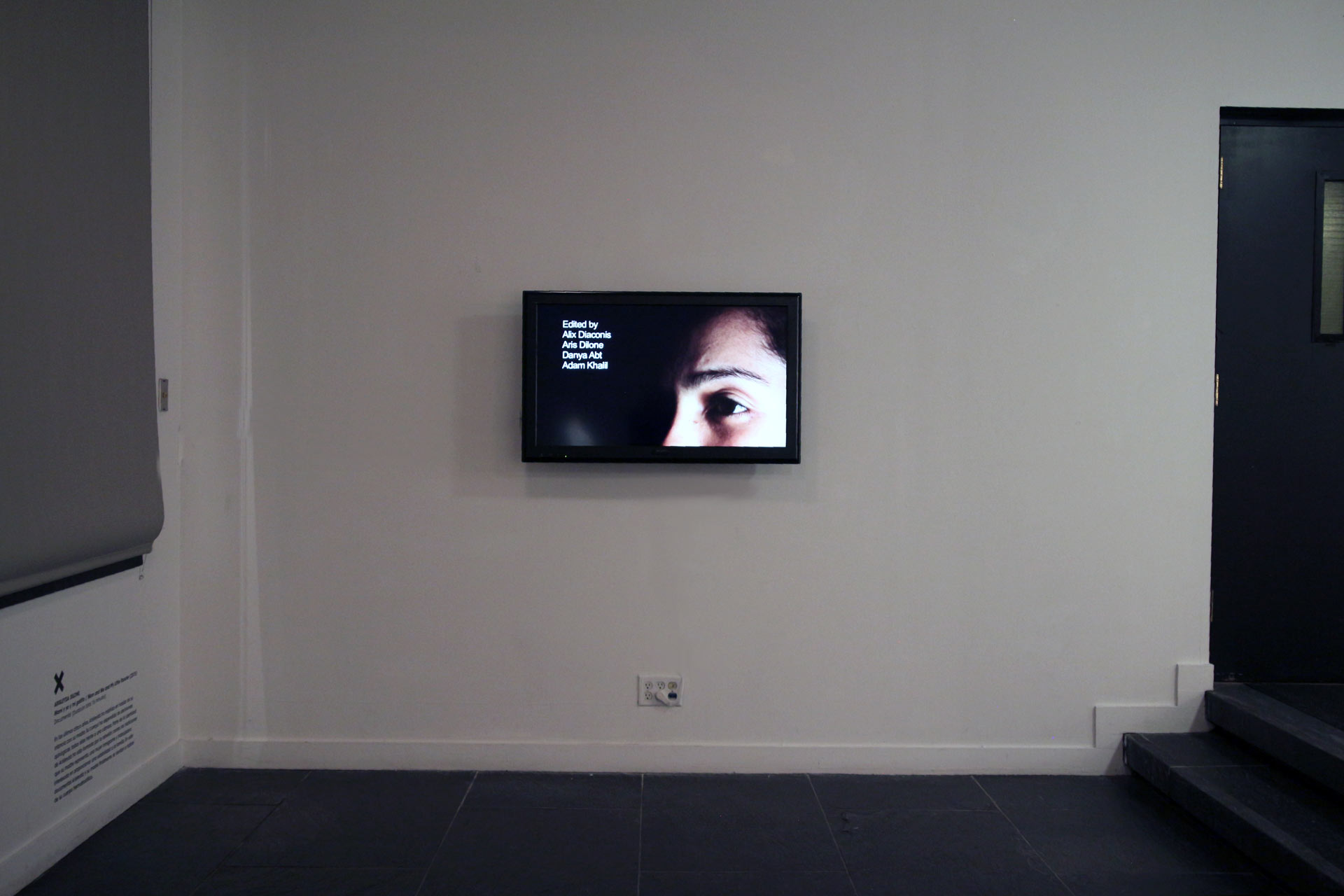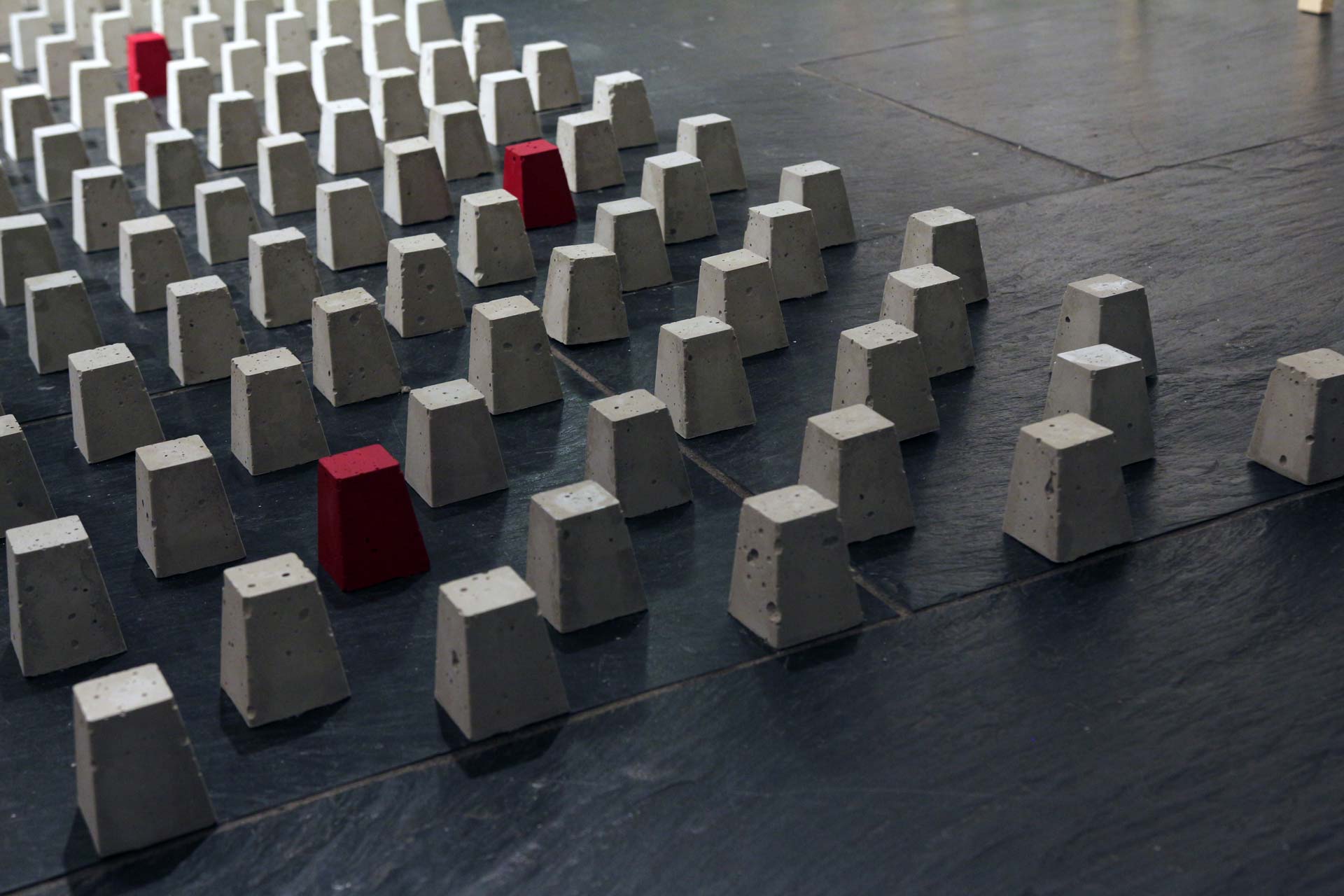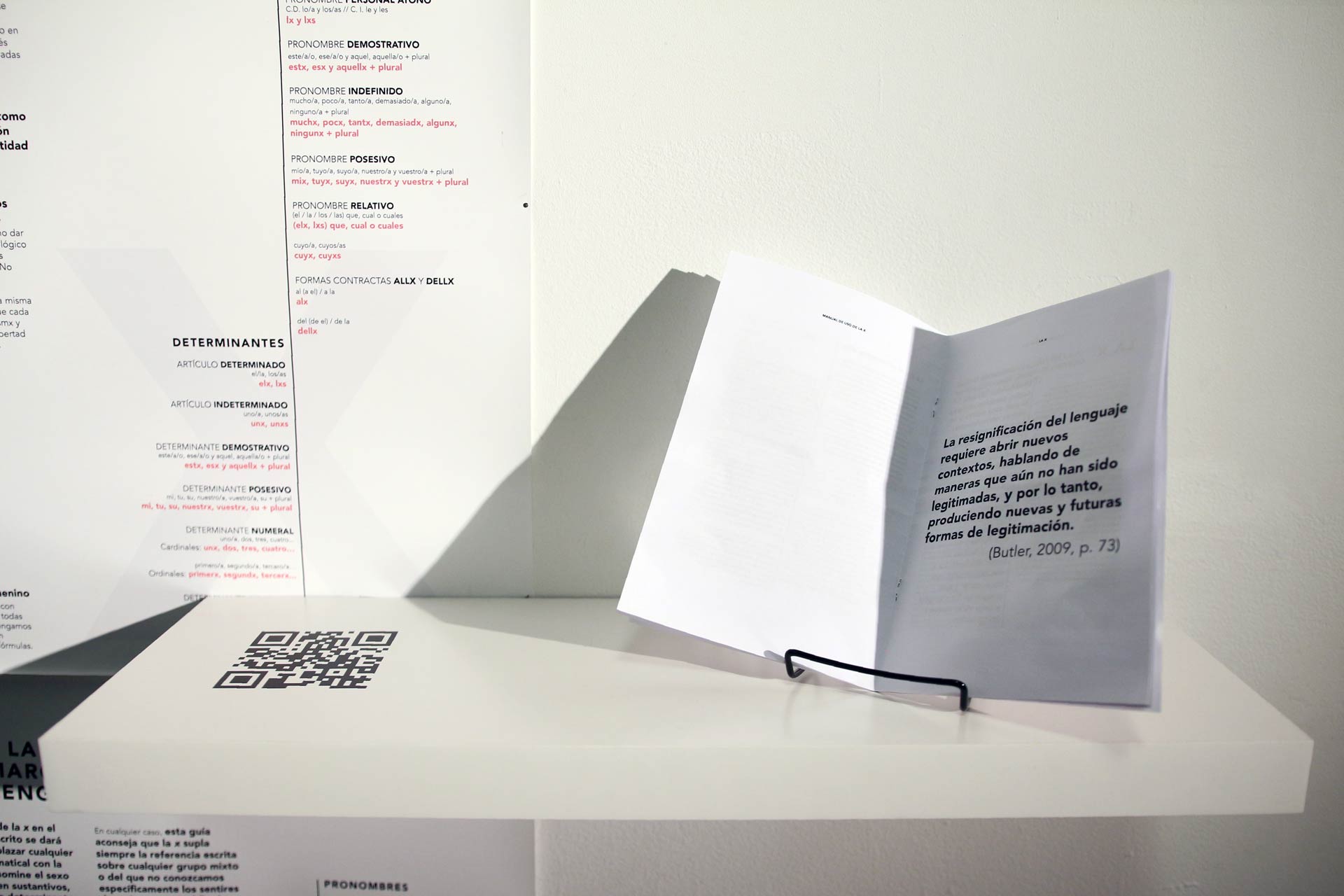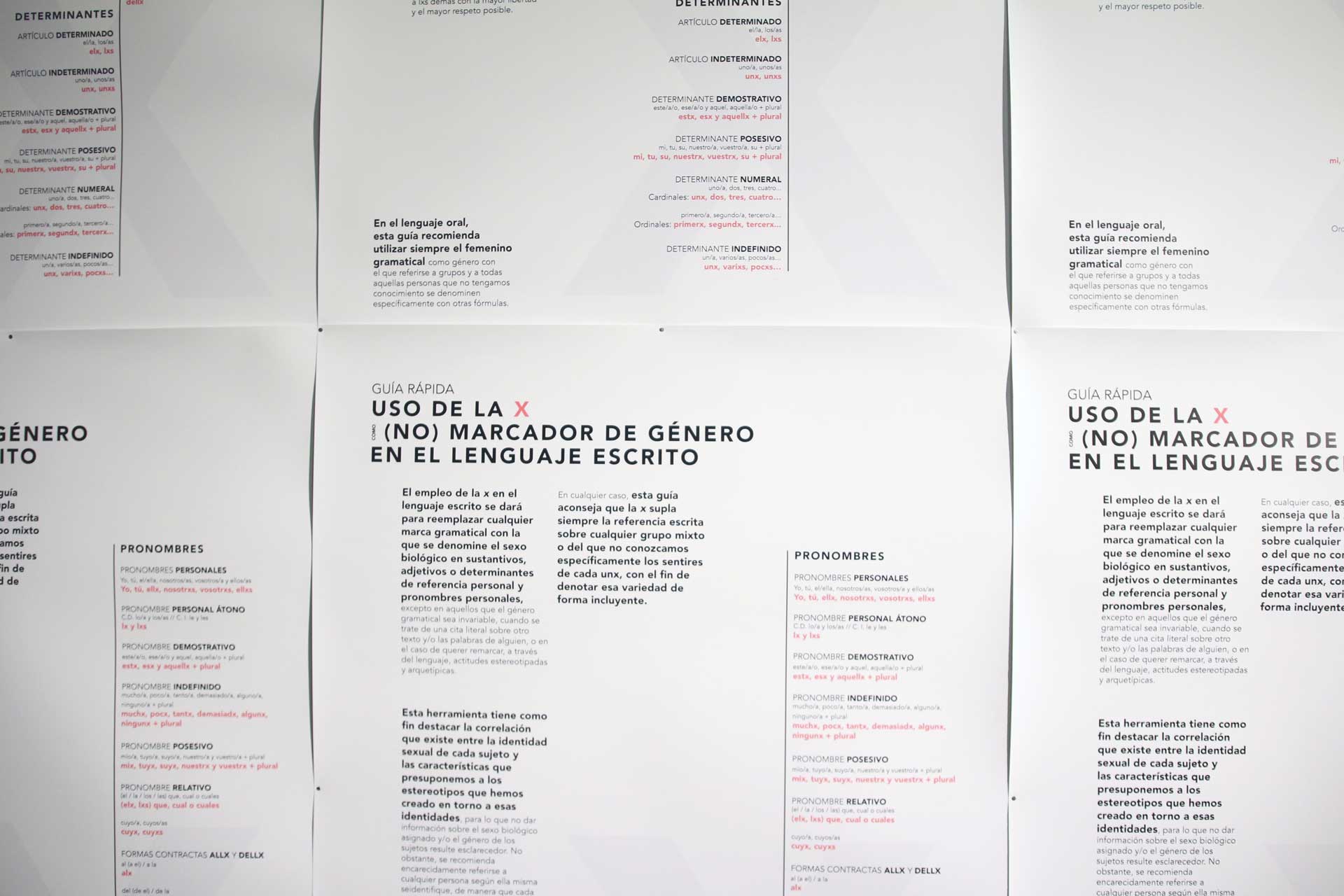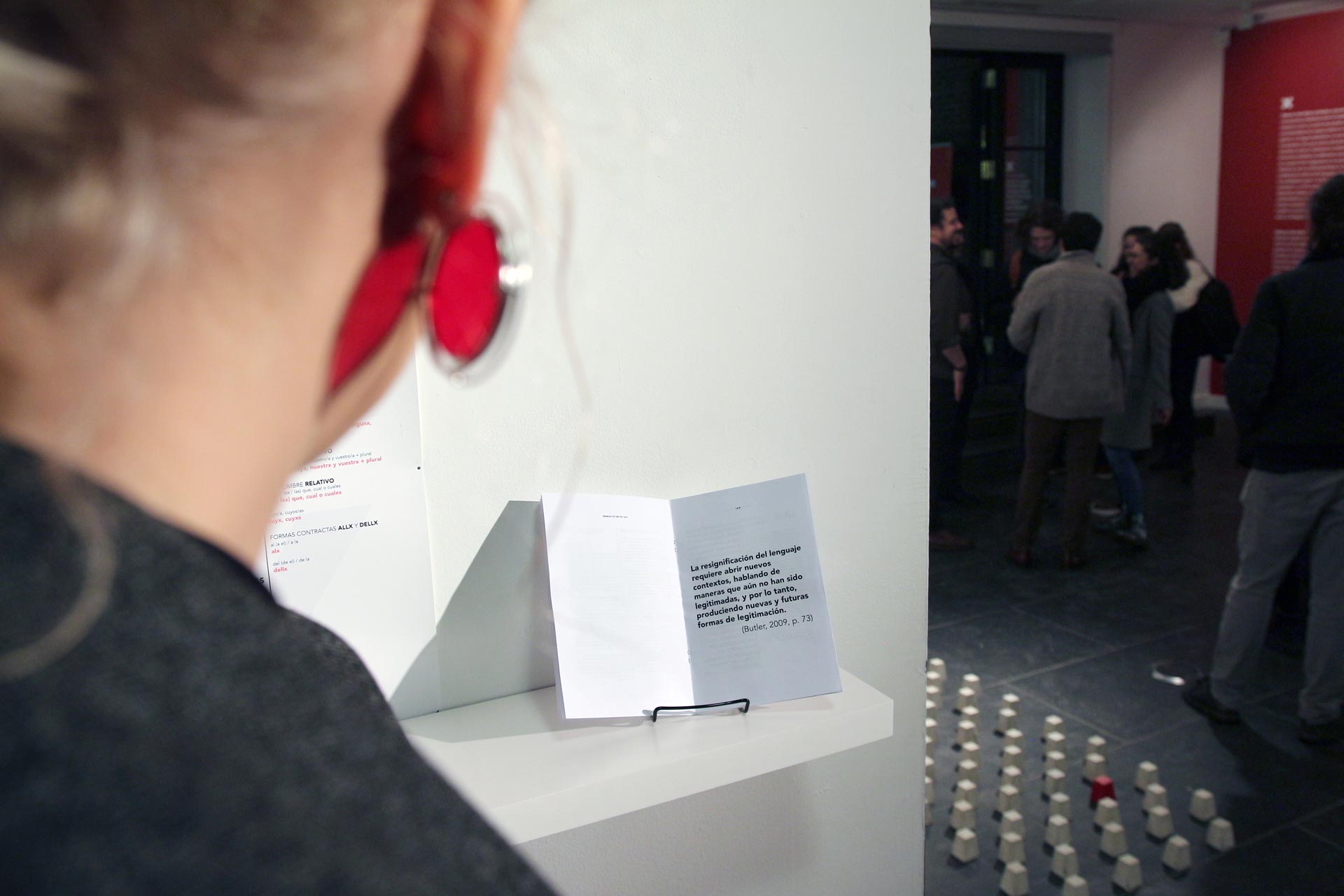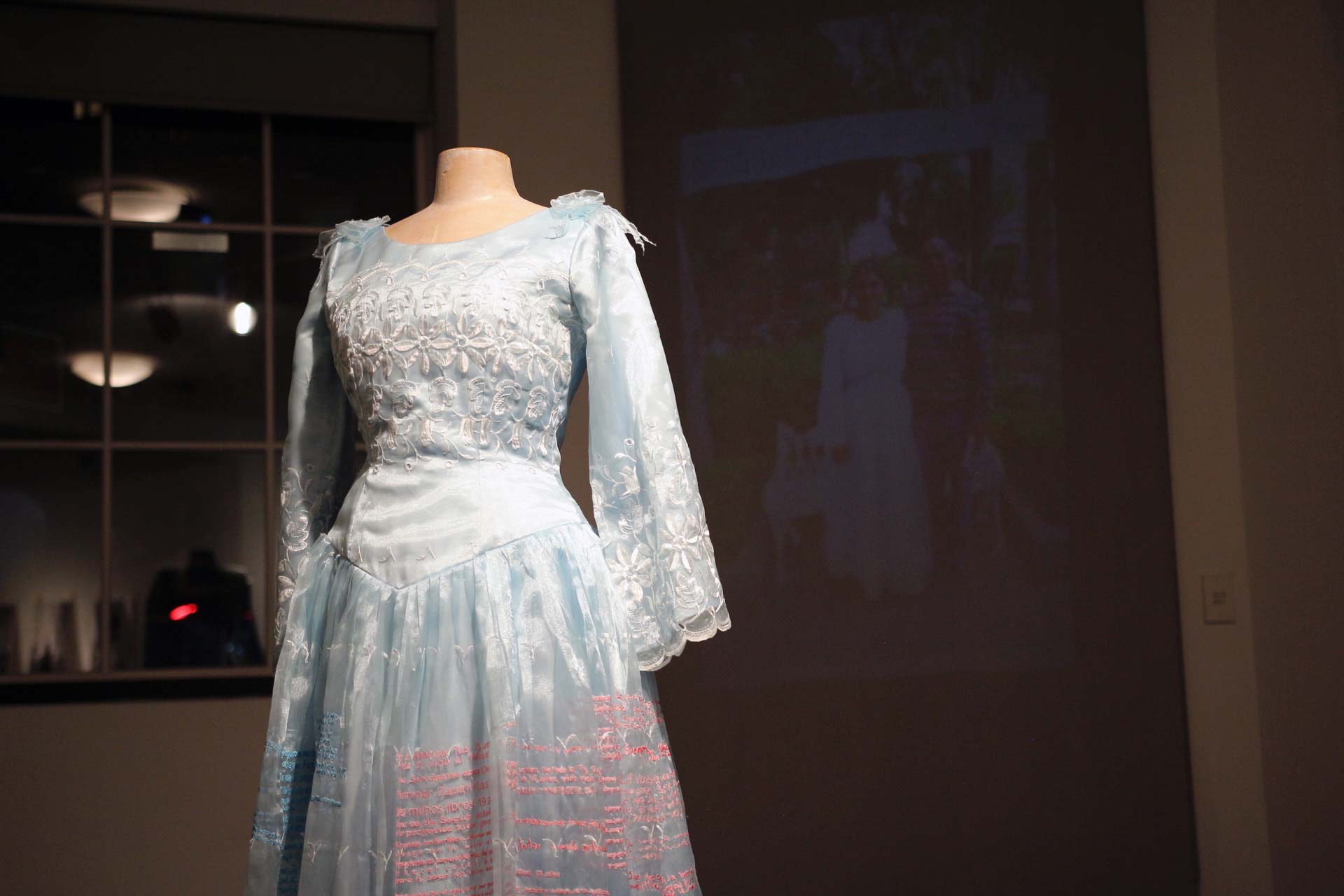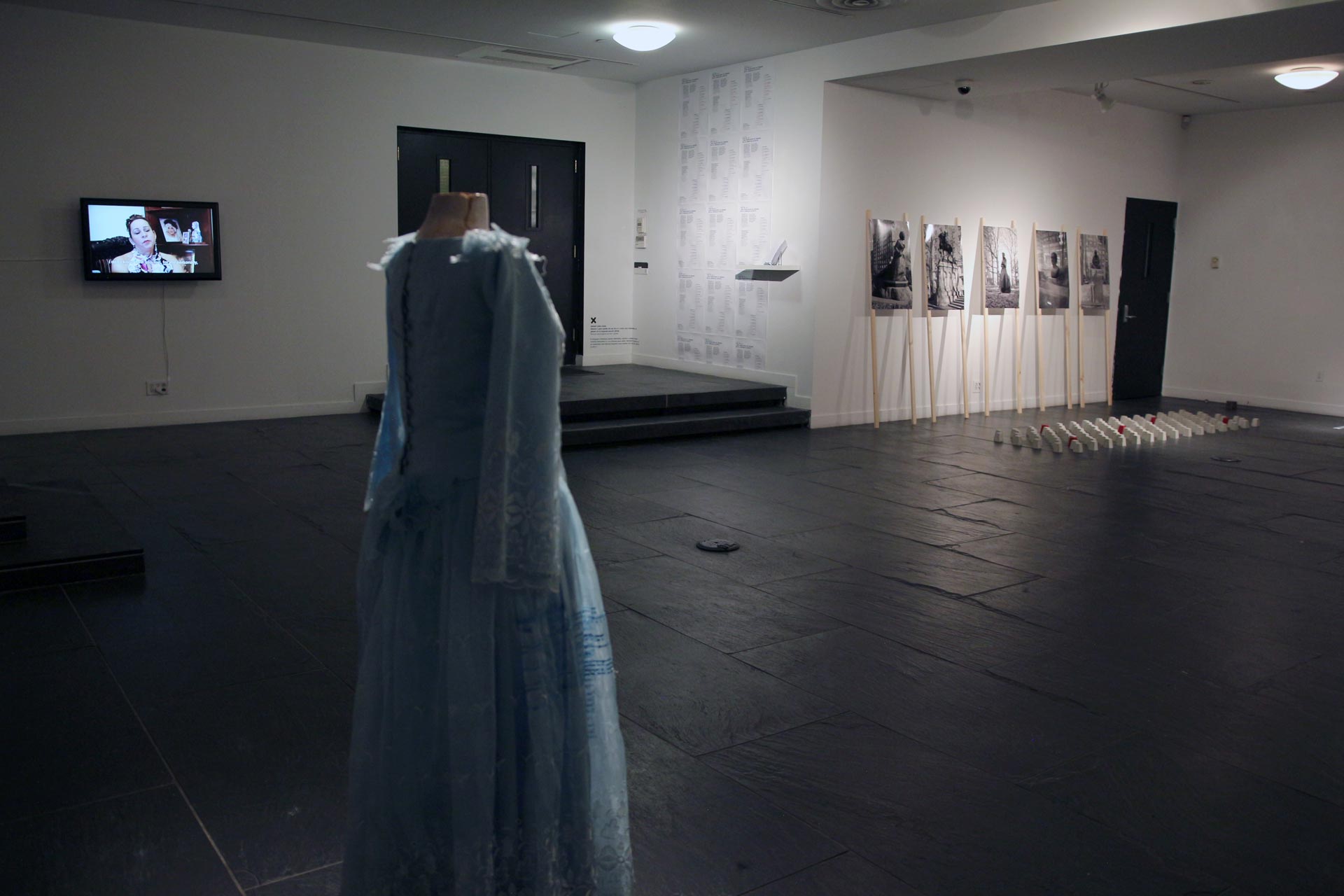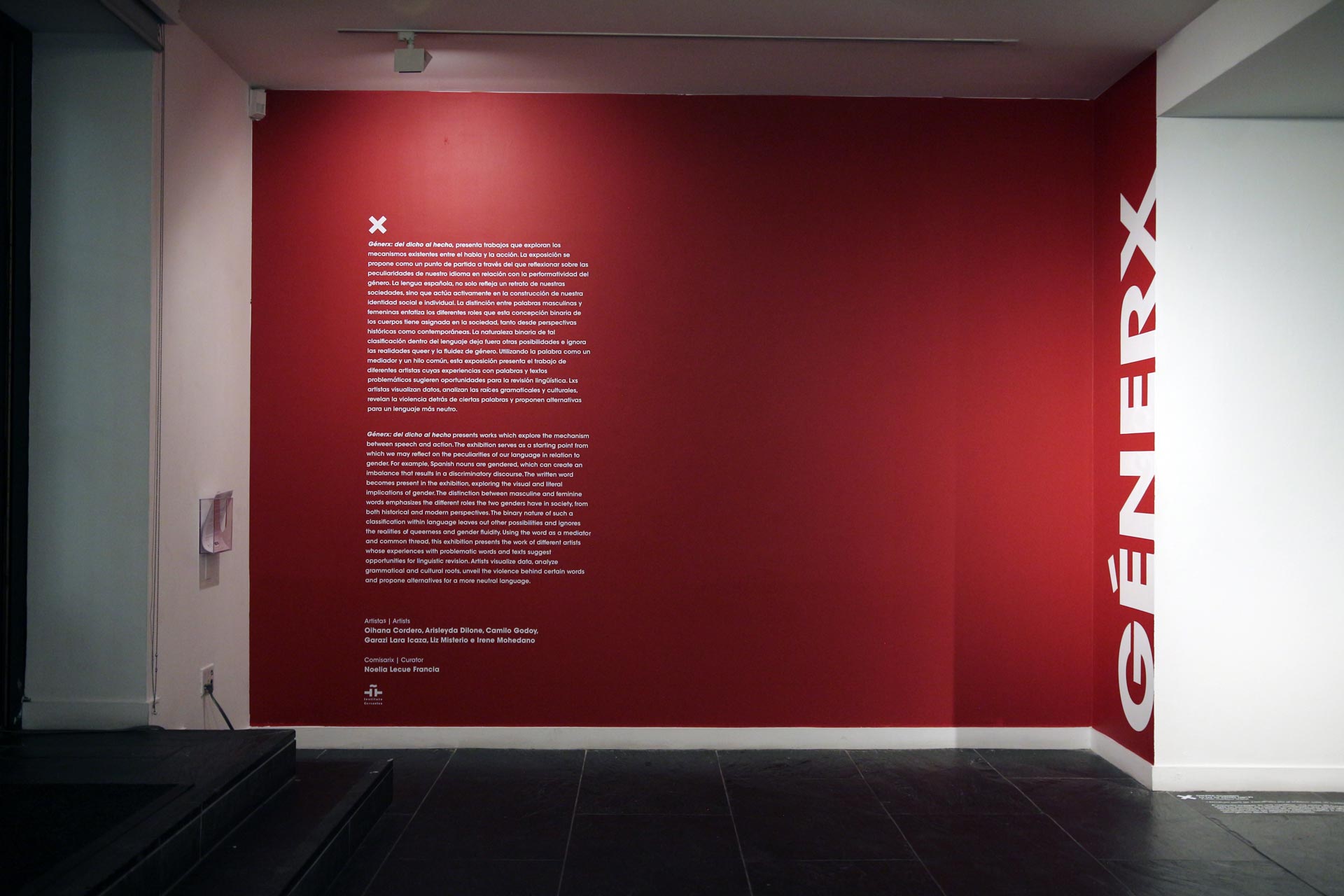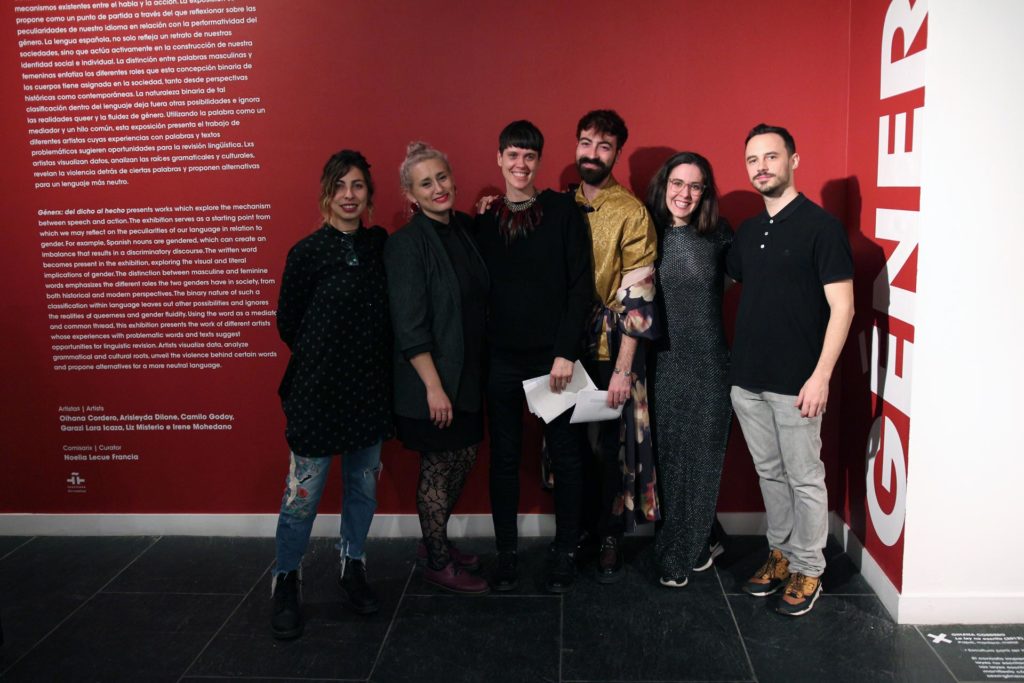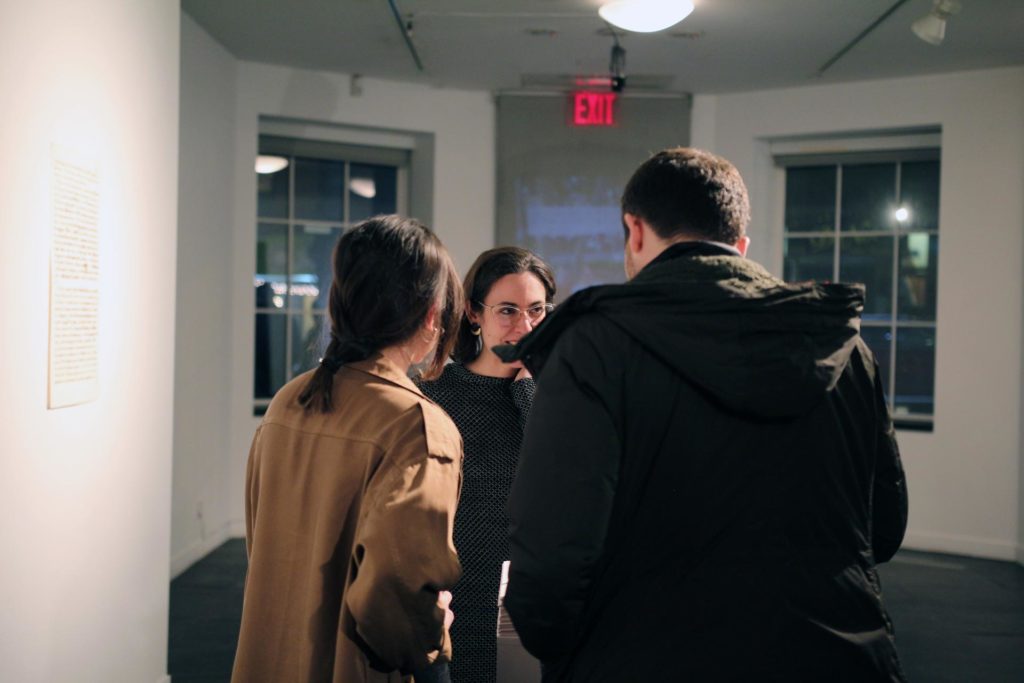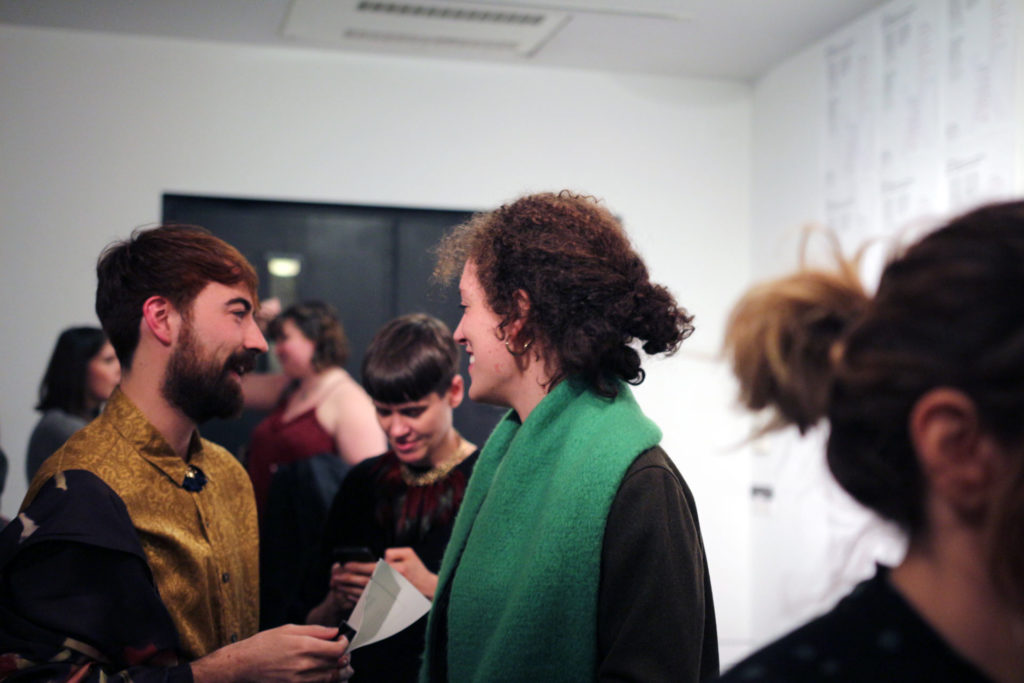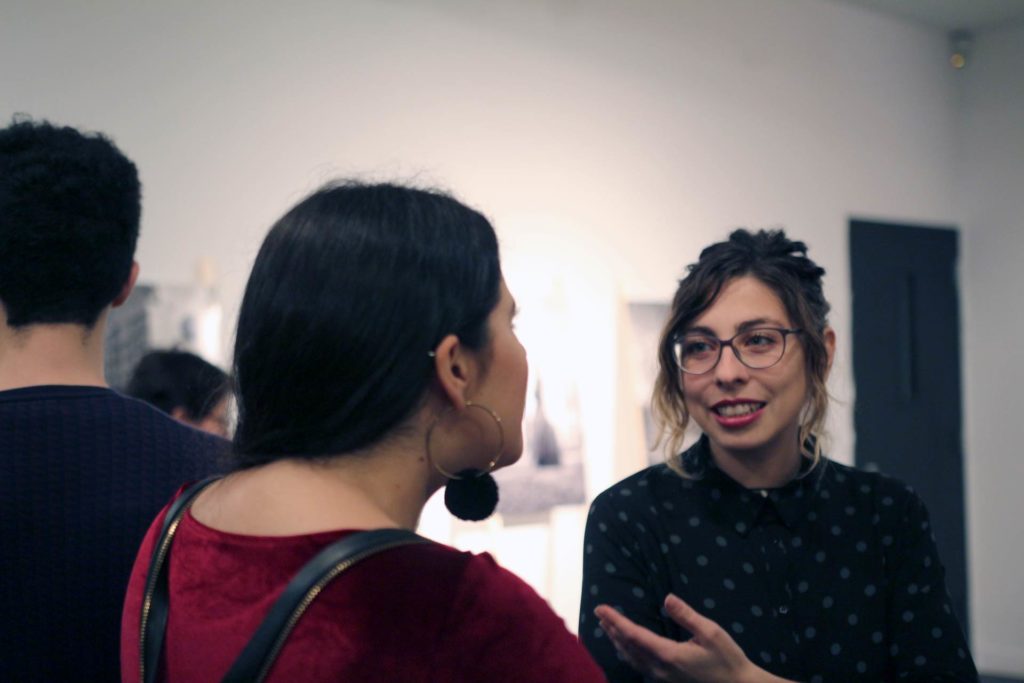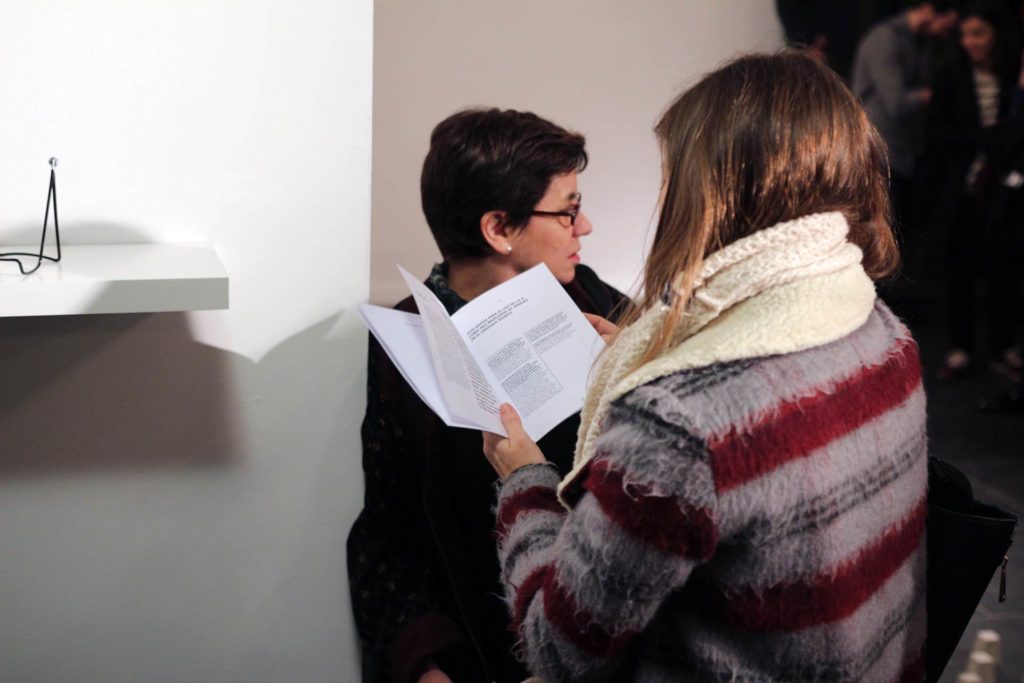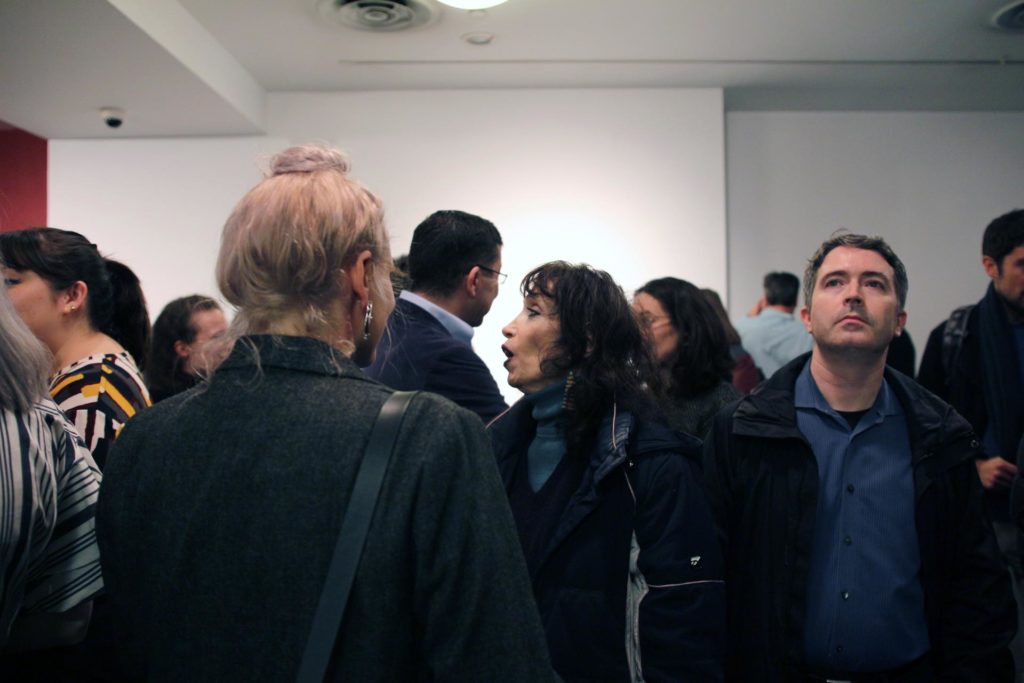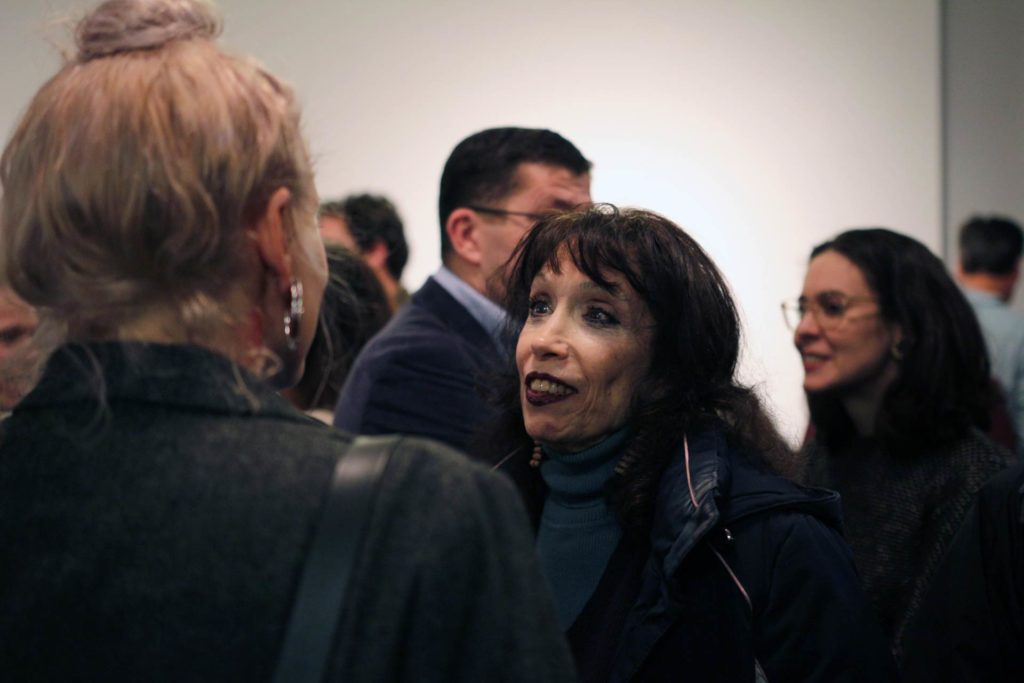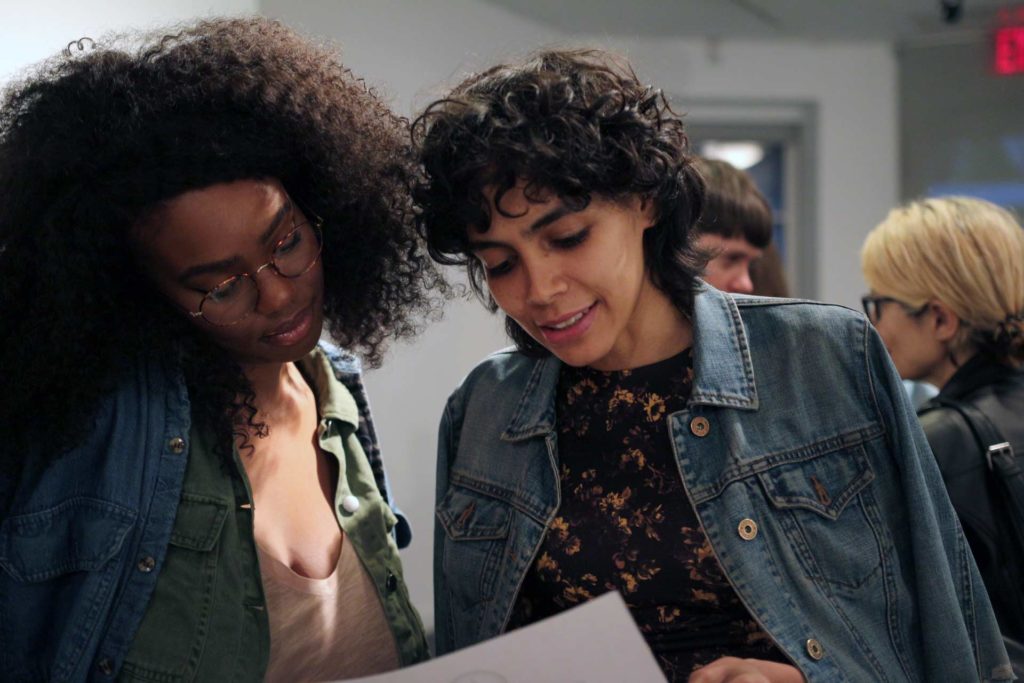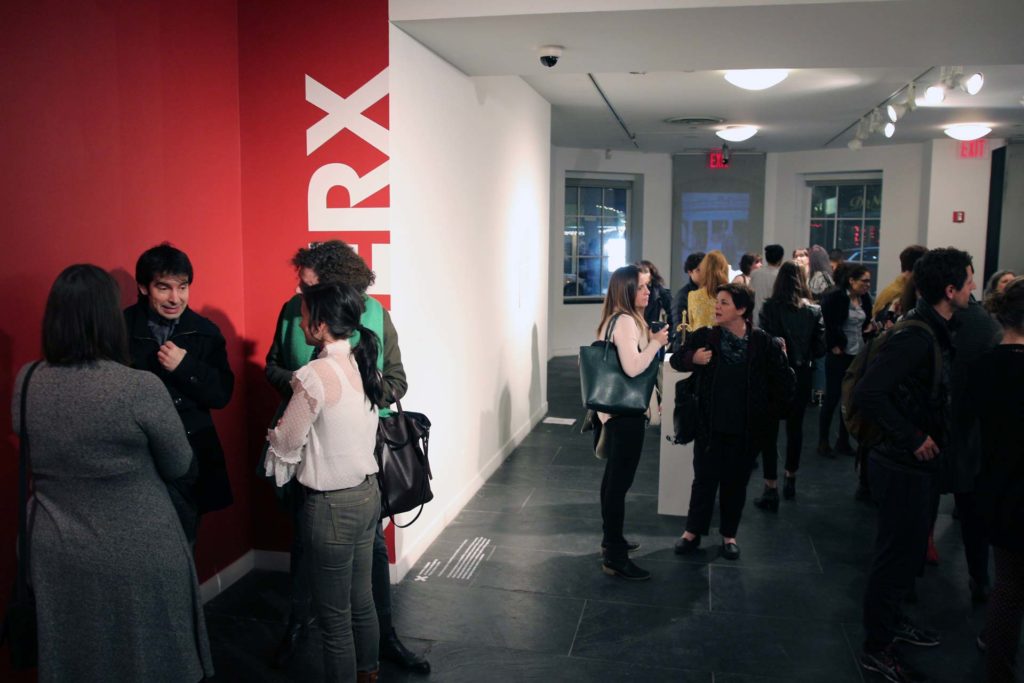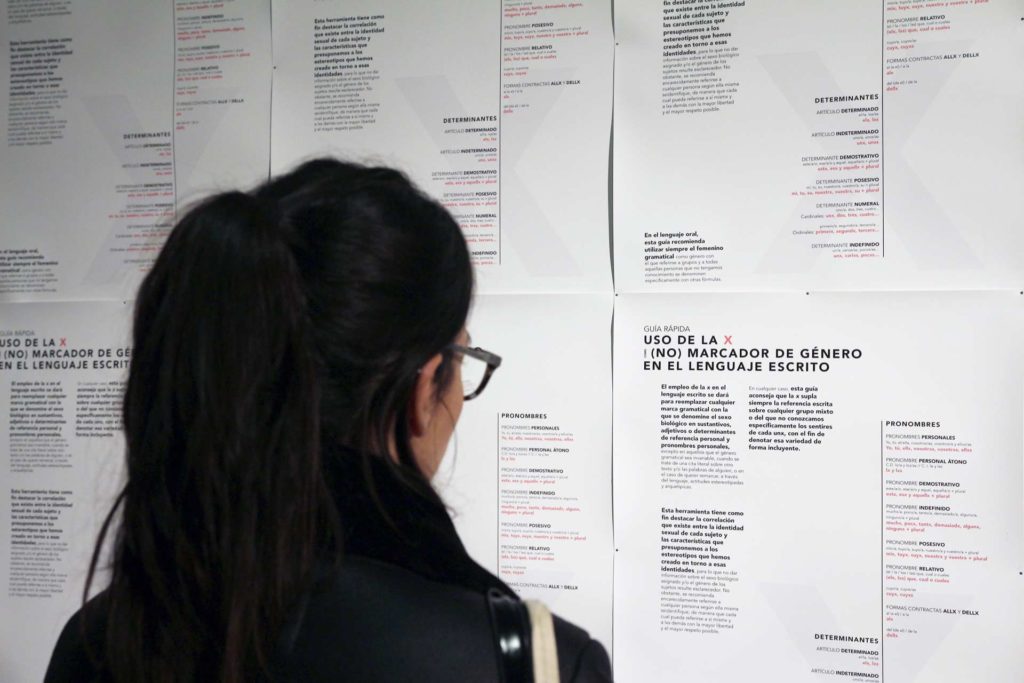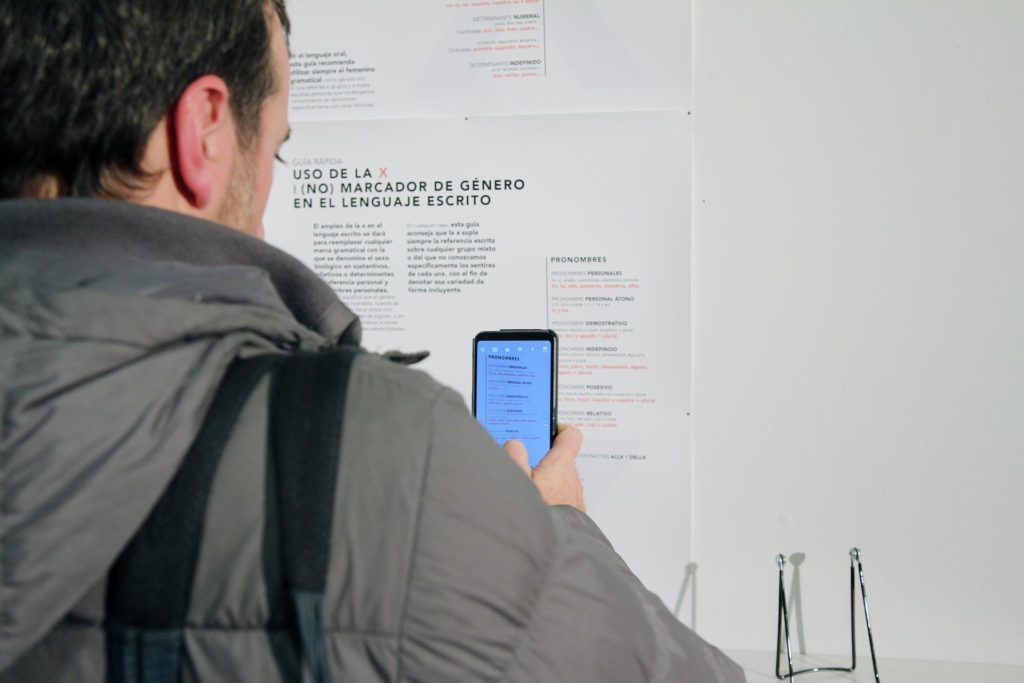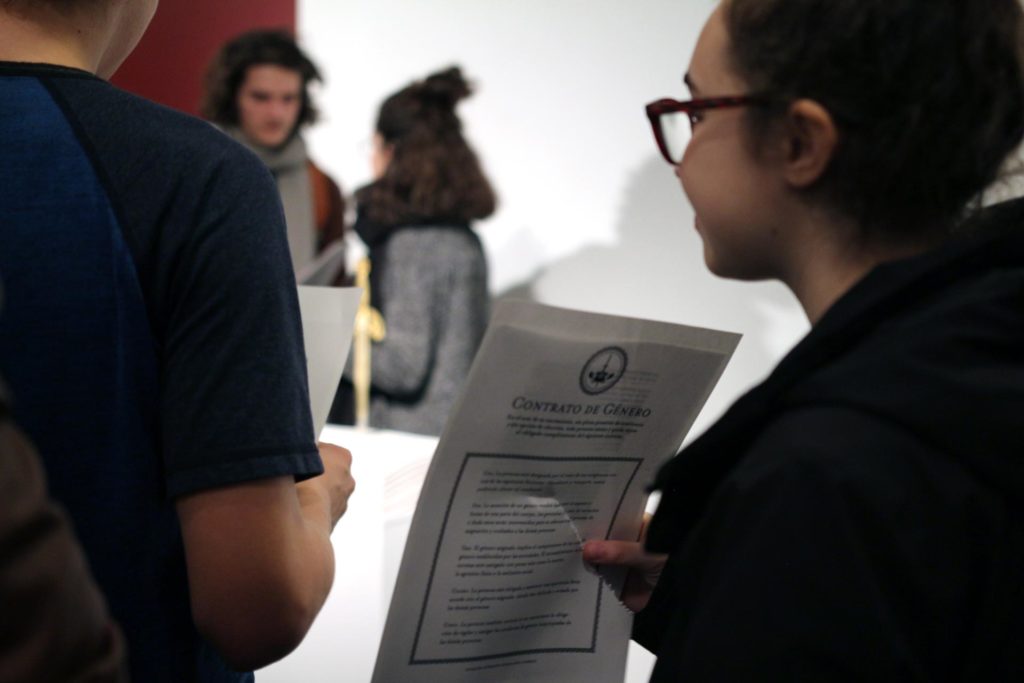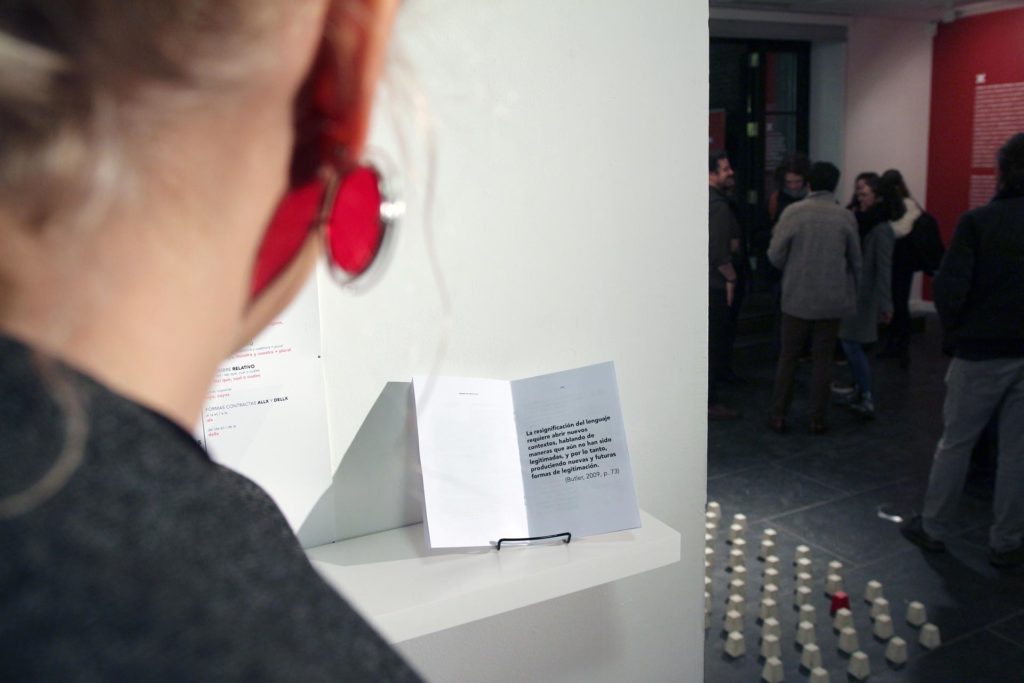Artists / Artistas:
Oihana Cordero
Arisleyda Dilone
Camilo Godoy
Garazi Lara Icaza
Liz Misterio
Irene Mohedano
Curated by / Comisariado por:
Noelia Lecue Francia
Dates / Fechas:
February 15 – March 5, 2018
Open Mon – Fri 10AM-PM; Sat 10AM-2PM
Opening Reception / Inauguración: Thursday February 15, 2018, 7-9PM
Venue / Lugar:
Instituto Cervantes New York
211 E 49th St, New York, NY 10017
Génerx: del dicho al hecho, is a multidisciplinary exhibition based on the ideas of gender representation within the Spanish language. The exhibition was part of #Women, a monographic program that Instituto Cervantes has organized for the first term of 2018, featuring women contributions in different artistic disciplines, the uniqueness of their work, the topics they address, and the richness of their standpoints.
“The illocutionary act is one in which in saying something, one is at the same time doing something.”
Butler, Judith. (2009). Lenguaje, poder e identidad. (Trad. Javier Sáez y Paul B. Preciado). Madrid, España: Síntesis.
Génerx: del dicho al hecho is an exhibition that analyzes the problematics of gender representation in the Spanish language, highlighting the connotations that underlie most binary definitions that our language has assimilated throughout its history. Currently studied in linguistics, visual arts, history, and philosophy by authors such as Judith Butler and Paul B. Preciado, gender and its representation through language influence how we analyze the construction of individual and social identity.
Génerx: del dicho al hecho presents works which explore the mechanism between speech and action. The exhibition serves as a starting point from which we may reflect on the peculiarities of our language in relation to gender. For example, Spanish nouns are gendered, which can create an imbalance that results in a discriminatory discourse. The written word becomes present in the exhibition, exploring the visual and literal implications of gender. The distinction between masculine and feminine words emphasizes the different roles the two genders have in society, from both historical and modern perspectives. The binary nature of such a classification within language leaves out other possibilities and ignores the realities of genderqueer and gender fluidity. Using the word as a mediator and common thread, this exhibition presents the work of different artists whose experiences with problematic words and texts suggest opportunities for linguistic revision. Artists visualize data, analyze grammatical and cultural roots, unveil the violence behind certain words, and propone alternatives for a more neutral language.
ABOUT THE ARTISTS
Oihana Cordero, BFA (2012) at the University of Granada, is currently an exchange researcher at Columbia University, and a PhD candidate at the UGR. Selected in 2017 as an Emerging Artist by Artistic Production Program of the UGR. Cordero has won prizes such as the 2012 Alonso Cano Prize for Artistic Creation, 2012 Málagacrea, and the 2012 Arena Foundation of Barcelona. Cordero has had solo and group exhibitions both national and international: CAC, (Málaga) Galería Alonso Vidal, (Barcelona), Basic House, (Madrid), Kleiner Salon, (Berlin), among others. She searches for strategies that question rules and unwritten laws. Cordero often proposes installations, sculptures, and drawings as reflections on gender constructions, emphasizing the relationship with identities and sexuality.
Arisleyda Dilone makes film work about her life and her family. Born in Santiago de Los de Caballeros, Dominican Republic, she spent her formative years in a hillside village outside of the city of Santiago. At the age of seven she was brought to New York and raised in a suburb of Long Island. She is the first in her family to attend and graduate college. Before films, she worked in local NYC politics and international affairs. As a filmmaker, she was awarded a NALIP mentorship and she was a 2012 Jerome Foundation-Travel and Study Grant Fellowship. Dilone was a 2014 UnionDocs Collaborative Fellow and a 2015 Queer Art/Mentorship/Program Fellow. Dilone is a member of Diverse Filmmakers Alliance and Brooklyn Filmmakers Collective.
Camilo Godoy is a multidisciplinary artist whose practice is concerned with the construction of political meanings and histories. His work engages with conceptual, photographic, and choreographic strategies to negotiate questions that confront the politics of citizenship, imperialism, and sexuality. He is a graduate of The New School with a BFA from Parsons School of Design, (2012), and a BA from Eugene Lang College of Liberal Arts, (2013). Godoy was recently a resident at ISCP and was a 2015-2017 Artist-in-Residence at Movement Research; 2014 Keyholder Resident of the Lower East Side Printshop. His work has been presented at venues such as Center for Performance Research, New York; Movement Research at the Judson Church, (New York), Donaufestival, (Krems), and Mousonturm, (Frankfurt), among others.
Garazi Lara Icaza is a multidisciplinary artist who focuses on issues of gender, sexuality and language. The artist’s work has been shown individually and collectively in different exhibitions such as Entreacto, Galería Moisés Pérez de Albéniz (Madrid, 2014); Empoderadas, Sala Juana Francés (Zaragoza, 2017); Premio Joven, Centro de Arte Complutense, (Madrid 2015); Desencaja (Málaga and Córdoba, 2013). Lara Icaza holds a BFA from UGR and a MA in Art and Creation Research from the Complutense University of Madrid. Since 2013, Lara Icaza is part of Kit Caníbal, a collective which develops critical projects through practices such as curating and writing.
Liz Misterio, BA in Visual Arts from the National School of Plastic Arts, U.N.A.M. in Mexico. Participated in the Multiple Media Seminary 3 from 2008 to 2011 and published with them a homonymous book in 2011. Misterio has collaborated with the Art and Gender Workshop since 2009 and participated in more than 30 exhibitions and interventions in México. The artist’s work has been selected for exhibitions at the Woman Made Gallery (Chicago, 2013); V National Biennale of Visual Arts (Yucatán, 2011), and MUAC (Ciudad de México 2016), among others. Misterio has also developed public interventions with the support of the University Cultural Center Tlatelolco (2011) and Multiple Media Seminary (2010).
Irene Mohedano is a Spanish artist based in New York. After completing her BFA at the UCM, she was awarded a Fulbright scholarship and obtained an MA in Critical Theory and the Arts at SVA, New York. She researches how the mechanisms of representation build our experience of reality through a critical process of questioning and challenging hegemonic narratives, as well as on situations of conflict arising from hegemonic positions and relations of power and re-significance through several artistic practices. Her work has been exhibited both in Spain and New York, in venues such as BRIC Arts Media House, (NY), The Greenpoint Gallery, (NY), Centre del Carme, (Valencia), CentroCentro, (Madrid), and Casa Velázquez, (Madrid), among others.
ABOUT INSTITUTO CERVANTES
Instituto Cervantes is an institution that was founded by the Spanish government in 1991 to promote the Spanish language and Spanish and Hispanic-American culture. The central head office of the institution is located in Madrid (Spain) and Instituto Cervantes has 90 centers on all five continents. In New York, the Institute collaborates with museums, galleries, theaters, publishing houses and other cultural institutions, as well as Spanish and Latin-American organizations.
Génerx: del dicho al hecho, es una exposición multidisciplinar basada en las ideas de representación de género dentro del idioma español. La exposición fue parte de #Women, un programa monográfico que el Instituto Cervantes ha organizado para el primer trimestre de 2018, presentando contribuciones de mujeres en diferentes disciplinas artísticas, la singularidad de su trabajo, los temas que abordan y la riqueza de sus puntos de vista.
“El acto ilocucionario es aquel en el que al decir algo, uno hace al mismo tiempo algo”
Butler, Judith. (2009). Lenguaje, poder e identidad. (Trad. Javier Sáez y Paul B. Preciado). Madrid, España: Síntesis.
Génerx: del dicho al hecho, es una exposición que propone distintas miradas críticas sobre cómo se construye el género a través del lenguaje, destacando las connotaciones que subyacen en la mayoría de las definiciones binarias que nuestra lengua ha asimilado a lo largo de su historia. Actualmente estudiado en lingüística, artes visuales, historia y filosofía por autorxs como Judith Butler o Paul B. Preciado, el género y su representación a través del lenguaje influyen en cómo analizamos la construcción de la identidad individual y social.
Génerx: del dicho al hecho, presenta trabajos que exploran los mecanismos existentes entre el habla y la acción. La exposición se propone como un punto de partida a través del que reflexionar sobre las peculiaridades de nuestro idioma en relación con la performatividad del género. La lengua española, no solo refleja un retrato de nuestras sociedades, sino que actúa activamente en la construcción de nuestra identidad social e individual. La distinción entre palabras masculinas y femeninas enfatiza los diferentes roles que esta concepción binaria de los cuerpos tiene asignada en la sociedad, tanto desde perspectivas históricas como contemporáneas. La naturaleza binaria de tal clasificación dentro del lenguaje deja fuera otras posibilidades e ignora las realidades queer y la fluidez de género.
Utilizando la palabra como un mediador y un hilo común, esta exposición presenta el trabajo de diferentes artistas cuyas experiencias con palabras y textos problemáticos sugieren oportunidades para la revisión lingüística. Lxs artistas visualizan datos, analizan las raíces gramaticales y culturales, revelan la violencia detrás de ciertas palabras y proponen alternativas para un lenguaje más neutro.
SOBRE LXS ARTISTAS
Oihana Cordero es licenciada en Bellas Artes por la UGR (2012), actualmente es investigadora invitada en la Universidad de Columbia y doctoranda de la Universidad de Granada. Seleccionada en 2017 como Artista Emergente en el Programa de Ayuda a la Producción Artística de la UGR, Oihana ha ganado premios como el premio Alonso Cano 2012, Málagacrea 2012, Fundación Arena 2012, etc. Ha participado en exposiciones tanto nacionales e internacionales como: CAC, Málaga; Galería Alonso Vidal, Barcelona; Casa Básica, Madrid; Kleiner Salon, Berlín. Oihana busca estrategias que cuestionen las reglas y las leyes no escritas. A menudo propone instalaciones, esculturas y dibujos como reflexiones sobre las construcciones de género, que enfatizan en la relación con las identidades y la sexualidad.
Arisleyda Dilone hace peliculas sobre su vida y su familia. Nacida en Santiago de los Caballeros, República Dominicana, pasó los primeros años de su vida en un pueblo a las afueras de la ciudad de Santiago. A los siete años la trajeron a Nueva York donde la criaron en un suburbio de Long Island. Arisleyda es la primera en su familia en asistir y graduarse en la universidad. Antes de dedicarse al cine y el documental trabajó en política local Neoyorquina y en asuntos internacionales. Como cineasta, recibió una beca NALIP y fue becaria de la Fundación Jerome 2012 para estudios en el extranjero. Arisleyda fue socia colaboradora de UnionDocs en 2014 y becaria de arte querencia / mentor / programa en 2015. Arisleyda es miembro de Diverse Filmmakers Alliance y Brooklyn Filmmakers Collective.
Camilo Godoy es un artista multidisciplinar cuya práctica se relaciona con la construcción de significados e historias políticas. Su trabajo se relaciona con estrategias conceptuales, fotográficas y coreográficas para negociar las cuestiones que confrontan las políticas de ciudadanía, imperialismo y sexualidad. Se graduó de The New School con un BFA de Parsons School of Design, 2012; y posee un BA de Eugene Lang College of Liberal Arts, 2013. Camilo ha disfrutado de varias residencias artísticas tanto en ISCP (2017), en Movement Research (2015-2017), como en Lower East Side Printshop (2014). Su trabajo ha sido presentado en lugares como Center for Performance Research, Nueva York; Movimiento de Investigación en Judson Church, Nueva York; Donaufestival, Krems; y Mousonturm, Frankfurt, entre otros.
Garazi Lara Icaza, artista multidisciplinar que centra su práctica en torno cuestiones relacionadas con el género, la sexualidad y el lenguaje. Su trabajo se ha expuesto individualmente en Entreacto, Galería Moisés Pérez de Albéniz (Madrid, 2014); y colectivamente en Empoderadas, Sala Juana Francés (Zaragoza, 2017); Premio Joven, Centro de Arte Complutense (Madrid, 2015); Certamen Andaluz de Artes Plásticas, Desencaja (Málaga y Córdoba, 2013), entre otros. Licenciadx en Bellas Artes por la UGR, tiene un Máster en Investigación en Arte y Creación por la UCM. Desde 2013 forma parte de Kit Caníbal, un colectivo junto al que desarrolla proyectos críticos a través de diferentes prácticas como la curaduría o la escritura.
Liz Misterio, licenciada en Artes Visuales de la Escuela Nacional de Artes Plásticas, U.N.A.M. en México. Participó en el Multiple Media Seminary 3 de 2008 a 2011 y publicó con ellos un libro homónimo en 2011. Liz colabora con el Taller de Arte y Género desde 2009. Ha participado en más de 30 exposiciones e intervenciones en México. Su trabajo ha sido seleccionado para exhibiciones en la galería Woman Made (Chicago, 2013); V Bienal Nacional de Artes Visuales (Yucatán, 2011); MUAC (Ciudad de México 2016), entre otros. Liz también ha desarrollado intervenciones públicas con el apoyo del Centro Cultural Universitario Tlatelolco (2011) y el Seminario de Medios Múltiples (2010).
Irene Mohedano, es una artista española con sede en Nueva York. Después de terminar BFA en la UCM, recibió una beca Fulbright y obtuvo una maestría en Teoría Crítica y las Artes en SVA, Nueva York. Investiga sobre los mecanismos de representación que construyen nuestra experiencia de la realidad, a través de un proceso crítico de cuestionamiento y desafío de narrativas hegemónicas y las formas en que se asimilan, así como sobre situaciones de conflicto derivadas de posiciones hegemónicas y relaciones de poder y resignificación a través de varias prácticas artísticas. Su trabajo ha sido expuesto tanto en España como en Nueva York, en lugares como BRIC Arts Media House, NY; The Greenpoint Gallery, NY; Centro del Carme, Valencia; CentroCentro, Madrid; y Casa Velázquez, Madrid, entre otros.
